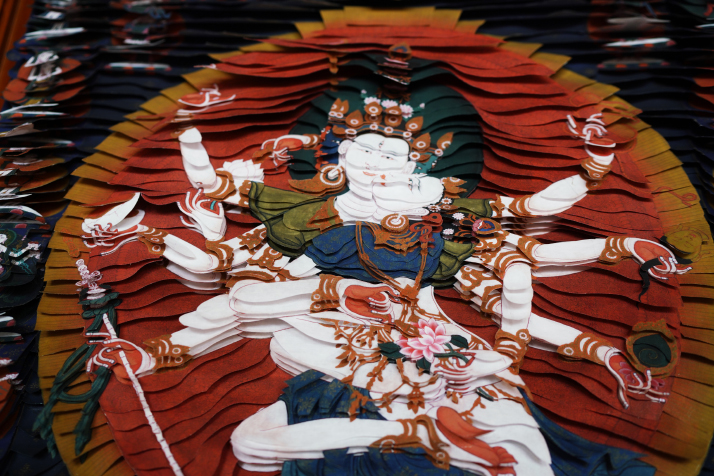Book designer brings a centuries-old technique back to life
- By Qin Bin
 0 Comment(s)
0 Comment(s) Print
Print E-mail Beijing Review, April 23, 2021
E-mail Beijing Review, April 23, 2021

With a cup of pu'er tea and a burning sandalwood incense stick on the desk, Zhang Xiaodong begins a day's work at his studio in Yizhuang in the southeastern suburb of Beijing. Zhang is the inheritor of the intangible cultural heritage known as Dragon Scale Binding.
Also called Fish Scale Binding, Dragon Scale Binding is an ancient bookbinding technique that emerged during the transitional period when collected writing shifted from scrolls to books formed with leaves during the Tang Dynasty (618-907).
The binding technique not only shortened the length of a book to facilitate a more efficient reading and searching process, but also vastly improved the reading experience. However, the original exquisite and intricate technique was once lost, and the only existing ancient book using this binding technique was preserved in the Palace Museum in Beijing.
Fortunately, Zhang brought it back to life.
Born in Zhangjiakou City, Hebei Province, in 1981, Zhang graduated from Shenyang Aerospace University. In 2008, he began to concentrate on book design. He studied under famous book designer Lu Jingren, Peking University Professor Xiao Dongfa, and renowned bookbinding expert Wang Huaizhu. When Zhang finally became a book design professional, the golden age of book publication had already passed with the rise of e-books and the decline of printed material.
"Back then, I thought the future of books would probably develop in two directions: e-books to meet the trend of fragmented reading in fragmented time and space, and a greater appreciation for the once-ignored functions of printed books—their physical properties, ornamental attributes, and functionality to convey emotions as a kind of tangible media, as well as their collectability," he recalled. "I believe that handmade books with the aforesaid functions represent a direction of future books."
That sentiment sent Zhang down the road to restore the lost art of Dragon Scale Binding. He consulted scholars, ancient painting restoration specialists, and printing experts from the Palace Museum and delved into researching historical material. After numerous experiments over two and a half years, Zhang eventually completed his first handmade book using Dragon Scale Binding: The Diamond Sutra in 32 Seal Scripts.
When opened, a book bound with this technique hearkens to a colorful dragon. As the breeze blows, the leaves dance gently, the illustrations in the book seem to come to life and leap into the reader's eye. "This is an expressive technique rich with Zen flavor that causes readers to become more immersed in the Buddhist sutra," Zhang explained.
That sentiment sent Zhang down the road to restore the lost art of Dragon Scale Binding. He consulted scholars, ancient painting restoration specialists, and printing experts from the Palace Museum and delved into researching historical material. After numerous experiments over two and a half years, Zhang eventually completed his first handmade book using Dragon Scale Binding: The Diamond Sutra in 32 Seal Scripts.
When opened, a book bound with this technique hearkens to a colorful dragon. As the breeze blows, the leaves dance gently, the illustrations in the book seem to come to life and leap into the reader's eye. "This is an expressive technique rich with Zen flavor that causes readers to become more immersed in the Buddhist sutra," Zhang explained.






Go to Forum >>0 Comment(s)